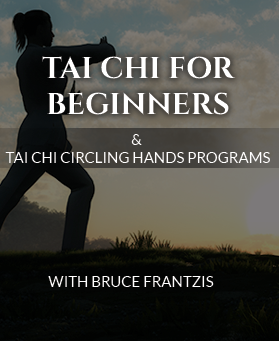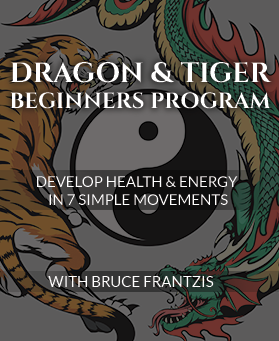In 1977, I was given a letter of introduction to tai chi master Yang Shao Jung, who did not accept students without a recommendation. Yang was the eldest son of Yang Cheng Fu, great-grandson of the original Yang Lu Chan. His school, located in his walk-up flat in the Wan Chai district of Hong Kong, was announced by a sign in beautiful Chinese calligraphy above the second-floor balcony. As in many of the older buildings in Hong Kong, the stairway was particularly dark.
Two major tai chi masters, Yang Cheng Fu and Wu Jien Chuan, had fled to the then British colony of Hong Kong for safe haven in the 1930s, a time of cascading troubles for China. Their oldest children remained in Hong Kong after World War II.
I knocked on Yang’s door and gave over the letter of introduction. Once it was read, I was admitted. The flat was small, as were most of those in the older buildings in Hong Kong then. To the right was the family’s private living quarters; to the left, the school. A few steps from the door was a small waiting area with a few places to sit. From this vantage, several things could be seen in the apartment. Straight ahead, a few feet away, you could observe Yang teaching in the next room, which seemed to be about 250 square feet. Toward the teaching room, above an opening in the wall, you could see pictures of Tung Ying Chieh and of Yang when he was younger.
Tung was one of his father’s main disciples who also taught in Hong Kong after the war and spread the teachings throughout Southeast Asia. To the left, next to the front door and against a solid wall, there were usually one or two groups that were practicing Push Hands.
Yang was a northern Chinese, solidly built, relatively tall and long-limbed for most in Hong Kong, being approximately 5’10. He was a warm, but very formal man who stood extremely erect. Most of the time I saw him, he wore black pants, black gung fu shoes and a loose-fitting shirt. The atmosphere of the front teaching room was businesslike, bare of furniture. Where the teaching room ended, the balcony began.
On those many days that were hot and extremely humid in Hong Kong, any wind through the balcony window was a welcome relief. Yang taught most of his classes in Cantonese, but he clearly was more natural in his native language of Mandarin, which he spoke with a marked Beijing accent.
Yang was pleased that I spoke Mandarin and often gave me a little extra time because I had taken the effort to learn his language and because of his innate sense of graciousness toward visitors from afar. Yang taught his classes as private lessons, which usually lasted 10-15 minutes with one student before another came into the room.
In his early classes, Yang emphasized several points when he taught:
- The most important was clarity. There was never anything vague about the way he taught. He was extremely precise about how each of your body parts should be positioned, and he shaped them in each movement of the form. If you missed a critical detail after observing his demonstration of the movement, he would physically adjust your limbs to ensure that you understood what was expected and what was necessary to maintain quality control.
- Second, he emphasized a clear 100/0 percent separation of weight in each stance. When I asked him why many others taught tai chi with other weight balances, he replied, “This is how my family has always taught the form since my great-grandfather.”
- Third, he stressed doing long stances, especially encouraging younger students to go very low.
- Fourth, he advocated large extended movements where the hands were always stretched out and relatively far from the body with the armpits extremely open. He encouraged students to lengthen their arms from the spine, often gently pulling their elbows or hands forward to set the feeling in their bodies.
I would often come early for his classes and stay after my form class so I could observe and learn more, which he graciously permitted. Sometimes, between students when it was not my turn, he would generously allow me to ask a question. It was very instructive seeing the source from which so many Yang style tai chi form versions derived.
For example, once I asked about doing pushes in the form with the fingers facing straight ahead, as some did in Taiwan. He said this was not the way of the Yang family, maintaining that the fingertips should be facing vertically upward as the palm pushed forward and advised me to look at his father’s book.
On another occasion, several of the students in his school had recommended that I go to a Taoist to learn about meditation, and I asked Yang if he taught that also. He replied that he did not, and the members of his family had not from the beginning. He explained that his family taught only the martial and qigong aspects of tai chi, and that if my interest was meditation I would need to look elsewhere. Another time, he told me he taught his family’s tai chi tradition because of the obligation to pass on that tradition. He admired the love and joy of martial arts that his great-grandfather had possessed.
Generally, Yang’s students were well-educated and some spoke English as well as Cantonese. Many with whom I talked were friendly and insightful individuals. The conversations were enjoyable.
Usually when I arrived for class, several people would be practicing Push Hands by the wall next to the door. They did a form of static Push Hands where people would stand facing each other in a Press Forward position without moving or yielding. The person who was facing the wall would attempt to discharge, uproot, and slam the other against the wall with minimal or no obvious external movement. The person with his or her back against the wall would attempt either to absorb the other’s power or to push the opponent only an inch or two (more, and the person pushed would land in the laps of those in the small waiting vestibule). Yang’s small, thin wife loved to do Push Hands with the waiting students, bouncing them against the wall.
The idea of doing Push Hands without turning the waist and yielding to a person’s power was unusual, and different from everything I had previously learned. The Push Hands activity caused me to become skeptical and curious at the same time. Observing protocol, I mentioned to Yang, after I had been doing the form for a while, that I had some experience in Push Hands and would like to understand what they were doing at the wall. Yang agreed and one Saturday I was invited to come to a Push Hands class.
When I came in, Yang was practicing with students in the main teaching room. He was putting his hands on their shoulders and bouncing them vertically in the air, always with a wide smile on his face. It was a small class of only six to eight people. In the waiting area, I asked one of them to do Push Hands. He showed me the two-person press method and explained that it was used to develop the ability to discharge. I was able to more or less neutralize him. Then he said I should really go for it. I did what I was familiar with—yielding, moving my waist and threw him against the wall again and again.
When Yang was done with vertically bouncing people in the other room, we all lined up against the wall in the main room and practiced the technique. Again, I turned, yielded and turned and countered successfully with a student who had been at tai chi a few years longer than me. Then, it was my turn to Push Hands with Yang. His power was significant and he easily bounced me after I yielded. Then, as I next attempted to yield, he held me fast with only his palms, locking me up tight so that it was not possible to yield or move my limbs or body in any direction, or exert any kind of power against him in any way. It was like being held by a magnet. Due to circumstances beyond my control, I unfortunately had to leave Hong Kong shortly thereafter. The straightjacket experience with Yang remained forever embedded in my mind.





0 Comments